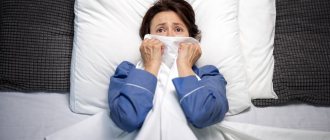A significant place in the practice of a dermatologist is occupied by skin diseases comorbid with mental disorders. According to W. Tress et al., mental disorders are observed in 35.5% of patients in dermatological clinics. According to German dermatologists O. Braun-Falco, G. Plewig, H. Wolff, about 20% of all those suffering from chronic dermatological diseases exhibit certain psychopathological disorders. Among dermatoses primarily caused by mental pathology, a very interesting nosological unit, insufficiently studied and little known to doctors of many specialties, is trichotillomania. Trichotillomania (TTM) is a disorder of habits and impulses characterized by noticeable hair loss due to repeated unsuccessful attempts to suppress the urge to pull it out. Corresponds to code F63.3 in ICD-10. TTM is the subject of study of a new branch of dermatology - psychodermatology, where dermatologists work together with psychiatrists to restore lost health to the patient.
Symptoms of trichotillomania
The symptoms of trichotillomania are visible to the naked eye. A person pulls out his own hair on his head, pubic area, eyelashes and eyebrows. At the initial stage, a small amount of hair falls out; in the future, the lesions will increase depending on the severity of the disease.
As a rule, a person twirls the hair on his head around his finger and then pulls it out; he removes eyelashes and eyebrows using tongs or other devices.
Patients pull out hair during stress (even the slightest), as well as while performing some monotonous activities (watching TV, reading a book, talking on the phone, etc.).
The skin on the damaged areas is completely healthy, without redness. However, there are times when the patient scratches areas of the skin until it bleeds.
In 10% of cases, patients eat plucked hair and also bite their nails. This leads to disturbances in the functioning of the gastrointestinal tract, the appearance of trichobezoars in the stomach (hair stones), and dental problems. Also considered complications of the disease are inflammation of the skin and eyes caused by infection.
STORY
The term “trichotillomania” was introduced in 1889 by the French dermatologist Francois Henri Hallopeau (1842-1919), who presented the medical community with the medical history of a young man suffering from itching of the scalp. When the itching became unbearable, the patient would tear out his hair in passion. The phenomenon was called trichotillomania. The name comes from three Greek words: trich - hair, tillo - tearing out, pulling out, mania - pathological attraction. Francois Henri Hallopeau In 1968, ED Vaughan, JL Sawyers and HW Scott described Rapunzel syndrome (named after the main character in the Brothers Grimm fairy tale of the same name about a girl with very long hair) - a type of intestinal obstruction caused by the systematic ingestion of hair (trichophagia), resulting in which causes a conglomerate consisting of hair (trichobezoar) to form in the stomach and small intestine. FV Mannino and RA Delgado in 1969 noted that TTM occurs more often in girls than in boys. In their opinion, the main cause of the disease is the disharmonious relationship between mother and child in early childhood, and TTM can only be treated with psychotherapy. In the domestic literature, O.B. was the first to describe TTM. Feltsman in 1918. In the USSR, the most patients were analyzed by V.I. Garbuzov (1971) and V.M. Bykov (1983).
Causes of trichotillomania
The nature of trichotillomania is not fully understood today. As a rule, the causes of trichotillomania are associated with mental disorders (neurosis, schizophrenia, stress, depression, obsessive-compulsive disorder), however, it can also be a consequence of a lack of iodine and copper, insufficient amounts of vitamins, head injury or concussion, thyroid disease , allergies to drugs or chronic tonsillitis.
By tearing out hair, patients try to suffocate mental pain with physical pain. They often deny there is a problem.
The Salvation psychiatric clinic employs professionals who can correctly determine the cause of the disease, which will allow the problem to be solved faster.
Not long ago, scientists proved that people who suffer from this disease have a damaged gene. This phenomenon is still poorly understood, so it is difficult to make assessments. The disease is often hereditary, which supports the theory.
Trigger
According to official data, about 5% of people worldwide suffer from trichotillomania. But this figure is inaccurate, since the lion's share of patients hide their addiction. People are able to hide their addiction for 20 years.
The majority of patients are women. More often, the disease debuts in childhood or adolescence, less often in the range of 20-30 years, and even less often after 40.
The development of the disease is based on the emerging feeling of tension and anxiety. The cause may be a guilt complex, fear, anger, anger and many other conditions that provoke a feeling of anxiety.
The skin where hair grows is well innervated thanks to a dense network of nerve fibers. This increases her sensitivity. A person who pulls out a hair feels pain. In this way, the patient switches attention from mental stress to physical sensations.
Self-inflicted pain acts as a way of self-punishment. Trichotillomaniac uses this method to relieve the stress that torments him. Endorphins, released under the influence of painful impulses, give a feeling of satisfaction, but only for a short time. Soon the feeling returns. The process is repeated.
There is an assumption that the disorder can also satisfy masochistic desires. Allegedly, the patient deliberately intensifies the pain in order to subsequently receive pleasure when the pain subsides. But this theory is just a guess.
Trichotillomania in adults
Trichotillomania in adults is more pronounced. Often, in the initial stages of the disease, adults try to hide the problem with the help of wigs, cosmetics, eyebrow tattooing, etc. Because of this, it can be difficult to identify the disease right away, which leads to complications in treatment.
Women suffer from trichotillomania almost 2 times more often than men. This is largely due to the fact that women pay more attention to their appearance.
Sometimes the disease begins with the pulling out of gray hairs. Some patients complain that the head begins to itch and after pulling out the gray hair, the tooth stops.
DIAGNOSTICS
Diagnosis of TTM is based on the collection of anamnesis and examination of the patient. Criteria for diagnosing TTM (Diagnostic and Statistical Manual of Mental Disorders (fifth edition) – DSM-5):
- Periodic pulling out of one's own hair, leading to hair loss.
- Repeated attempts by the patient to stop such actions or reduce their frequency.
- Hair pulling causes clinically significant distress or disruption in social, occupational, or other areas of importance to the patient.
- Hair pulling or loss cannot be explained by another medical condition (eg, dermatological).
- Hair pulling is not a symptom of another mental disorder (such as the patient's attempts to improve perceived defects or deficiencies in appearance, which can be observed in body dysmorphic disorder).
For the psychiatric assessment of TTM, a questionnaire is used. Many psychometric scales have been developed abroad to assess the severity of TTM (Massachusetts General Hospital Hair Pulling Scale, Psychiatric Institute Trichotillomania Scale, National Institute of Mental Health (NIMH) TTM severity scale, etc. .). The main objectives of the survey are to find out: 1) the average time spent on hair pulling; 2) ways to resist the urge to pull out; 3) is it possible to control the urge; 4) how the patient feels before and after pulling out; 5) degree of subjective discomfort; 6) the impact of the disease on the quality of everyday life. During a dermatological examination, the following are determined: - areas of thinning hair or baldness on the scalp, eyebrows, eyelashes, pubis; - foci of alopecia are single or multiple, round, linear or bizarre in shape; - the skin in areas of baldness is normal or rough to the touch; - the mouths of the hair follicles are clearly marked; - hair is usually of different lengths, may be broken off in the middle or look like small black dots or stubble; - skin excoriations in areas of baldness and manifestations of pyoderma are not uncommon - crusts covering excoriations, pustules, erythema, swelling; - no peeling; ‒ hair-pulling test along the edges of bald areas is negative. Trichoscopic signs of TTM: - reduced hair density; - hair broken off at different lengths; - short hair with symptoms of trichoptilosis (split ends); - unevenly twisted hair; - blackheads (cadaverized hair, which are comedon-like follicular blockages); - presence of vellus (short vellus hair); - hair powder (remains of the hair shaft damaged as a result of mechanical action); - absence of hair in the form of “exclamation marks” (dystrophically altered hair, narrowed in the proximal part). Videodermatoscopy for TTM (photo from the collection of Doctor of Medical Sciences, Prof. Yu.V. Sergeeva) An additional sign is the examination of the fingernails - in patients they are very sharp and shiny as a result of constant friction. Infection and damage to the skin of the fingers, which constantly pull out hair, are possible (the tips of the thumb and index fingers are most often affected). A trichogram can be of great help in diagnosis, the analysis of which reveals: - anagen hair with torn root sheaths; - complete absence of telogen hair; - increased density of catagen hair; - injured hair follicles without perifocal inflammation; - atrophic catagen hair; - sometimes you can detect the phenomena of trichomalacia.
Trichotillomania in adolescents
Trichotillomania in adolescents may be associated with hormonal changes in the body or with psychological disorders. At this age, a person reacts very sharply to what is happening, so problems in the family, frequent quarrels between parents or their indifference to the child’s problems, ridicule from peers and problems with socialization lead to a worsening of the condition.
Teenagers suffering from trichotillomania try to avoid contact with people and spend most of their time alone.
The task of parents is to find a common language with the child, stop criticizing over trifles, help him socialize and solve psychological problems.
If the problems are related to hormonal changes, then medications can be effective. They are prescribed by a doctor after consulting an endocrinologist and passing all the necessary tests.
What is trichotillomania and ICD 10 code
Trichotillomania (code according to the international classification of diseases F 63.3) – pulling out hairs on any part of the body. Typically, patients depilate themselves using their hands. Sometimes objects are used for this purpose - tweezers, pins, needles. The process is complemented by playing with hair, eating it, and biting nails. The causes of the disorder most often lie in the psychological status of the person. Often patients hide their attraction. Such secrecy is inherent in male patients. The main contingent of those suffering from the disease are teenage girls whose problem was noticed by their parents.
Areas subject to auto-depilation:
- face (eyelashes, eyebrows);
- limbs;
- breast;
- stomach;
- head;
- pubis.
If trichotillomania is suspected, the patient is consulted and examined by a dermatologist and psychiatrist, followed by a questionnaire and a trichogram (diagnosis of the condition of the hair and scalp).
This diagnosis is not made after skin inflammation precedes such behavior, or in cases where autodepilation is a reaction to delusions and hallucinations.
Treatment of trichotillomania
Treatment of trichotillomania begins with diagnostic measures: it is necessary to exclude the possibility of fungal diseases and syphilis. The patient also needs to undergo a general blood and urine test so that the doctor can assess the general condition of the body.
At this stage, the doctor interviews the patient and his relatives, finds out the patient’s diet and habits. It is also necessary to consult a dermatologist, neurologist and endocrinologist. This will help identify concomitant diseases. If the patient eats his hair, a consultation with a gastroenterologist may also be scheduled.
At the initial stage, it is very important to determine the cause of the disease. 60% of the success of treatment depends on this.
Due to the fact that the nature of the disease is still poorly understood, it is treated using the same means as for other psychological diseases - sedatives and antidepressants. Radiotherapy is also used to stimulate the spinal cord roots. Drug treatment in children is not effective.
The doctor necessarily prescribes a diet rich in iodine and copper, vitamin A, and prescribes vitamin-mineral complexes.
Patients have their scalp and pubic hair completely shaved and their eyelashes and eyebrows removed. Such measures have a short-term effect (until the hair grows back), but during this time it is possible to provide psychological support to the patient and eliminate the causes of the disease. Doctors also recommend wearing a special headdress that makes it impossible to pull out hair.
Great attention is paid to providing psychological support. Psychologists work with patients both individually and in group sessions. In addition, hypnosis and cognitive behavioral psychotherapy are actively used. They can be very effective.
General therapy also includes the treatment of eye or skin diseases that appear as a result of trichotillomania.
Childhood variant of the disorder
The development of trichotillomania in children is primarily influenced by the way they are raised:
- The disorder in most cases develops in a child with a developed sense of guilt or an inferiority complex. This is facilitated by raising children in an atmosphere of increased severity, total control, constant reprimand and inflated demands;
- overprotective parenting model;
- coldness, lack of attention. So, a 4-year-old boy pulled out all the hair on his head. When his mother brought him to the reception, during the conversation it became clear that the boy was experiencing an acute lack of parental love. The father drinks heavily, so he does not pay attention to his son. The mother works two jobs to support the family. Due to lack of time, he communicates little with the child;
- conflicts between parents, their parents' divorce.
The lack of an emotional response from loved ones also affected the 9-year-old girl Lena. She did not have a father, her mother paid little attention to her daughter, devoting all her free time to organizing her personal life. Lena has a guilt complex. The girl believes that she caused her mother a lot of grief. She is constantly told stories about how her mother suffered during pregnancy. The birth itself caused complications in the uterus, which had to be removed.
Lena went to kindergarten early. The girl let her mother go every morning with tears. The woman did not show a drop of sympathy. The child had to be calmed down by the teachers.
At the age of 5, Lena developed a tendency to pull her hair while lying in bed before going to bed. Unnoticed bald patches appeared on the head. The mother took the child to the doctor who prescribed treatment. There was no desired effect after therapy. They did not find out the reason.
Only at the age of 9, when the girl went completely bald, became fearful and closed, did Lena’s mother take her to a psychiatrist, who diagnosed trichotillomania.
In childhood, the disease begins to manifest itself after 3 years. Such kids carry out auto-depilation uncontrollably: while playing, watching cartoons, and also in situations of stress. The child does not try to hide pathological actions.
In adolescents, in addition to the costs of education, trichotillomania is provoked by a tense environment in the school community and problems in communicating with peers.
Adolescent trichotillomaniacs are already prone to deliberately causing hair mutilation to themselves. They perform rituals manually or prepare tweezers. The procedure requires privacy. The disease brings them discomfort. Children try to control their actions, but control over rituals only strengthens their manifestations.
A 13-year-old girl went on summer holidays with a friend and her family to relax at their dacha. The girl was so struck by her friend’s warm relationship with family members, in contrast to her relationship with her parents, that two weeks later the mother did not recognize her daughter. Upon arrival home, the girl returned completely without eyelashes. Trichotillomania was triggered by contrasting relationships between parents and children in different families.
The clinical picture of the disease is similar in adolescents to adults. There is an element of awareness of the mutilation. Teenagers also try to hide traces of auto-depilation: they wear hoods and robes. Often, a half-plucked eyebrow becomes an indicator.
Treatment of trichotillomania at home
Treatment of trichotillomania at home is effective only if the cause of stress has been completely eliminated. The most effective treatment is considered to be one in which the patient underwent a course of psychotherapy in a medical institution, and then returned home, where he continued treatment. As you know, houses and walls are treated, conditions are better than in a hospital.
As for trichotillomania in children and adolescents, the disease goes away quite quickly as soon as the parents are able to come to an agreement among themselves and reconsider their views on raising a child.
The attending physician continues to advise the patient and his relatives on treatment issues, and if a relapse occurs, the patient must be immediately taken to the facility.
general information
Getting rid of hair on the head, under the arms, in the pubic area and other places of the body often accompanies a number of mental illnesses or indicates extreme nervous imbalance of the patient. And treatment of trichotillomania should begin with identifying the factors contributing to its development. The disease is registered in women twice as often as in men. Often combined with trichaphagia. With such a deviation, when examining the patient, areas of baldness, single or multiple, are noted. They are characterized by a symmetrical location and unchanged skin in the affected area.
When interviewed, it turns out that the person does not pay attention to such behavior and even denies self-damage to his hair. There are variants of trichotillomania, in which the patient complains of itching of the scalp and pulls out exclusively gray hair, supposedly in this way alleviating his condition. According to the international classification, this pathology was classified as a desire disorder.
According to the latest research data, it was found that many patients with this diagnosis have a damaged certain type of gene. If such a theory is clearly confirmed, then it will be possible to carry out etiological treatment of trichotillomania.
Reviews about the treatment of trichotillomania
Reviews about the treatment of trichotillomania at the Salvation psychiatric clinic are only positive. Real professionals with extensive experience work here who can cope with even the most complex problem. They will find a caring approach to each patient and will make their stay at the center more pleasant and comfortable. Doctors work not only with the patient, but also with his relatives, which allows them to eliminate the cause of the disease.
The center is located away from the noisy city in an ecologically clean area. This allows patients to enjoy nature and walk around the center.
The center itself has all the necessary equipment and medications for the treatment of many psychological diseases.
A clear advantage of the center is good living conditions. The buildings have been renovated, all rooms are equipped with everything necessary.
Treatment at the center is carried out anonymously, which will not negatively affect the patient’s reputation. After completion of treatment, the center’s workers will help the person socialize and even get a job.
Methods for removing ingrown hairs
What to do if hairs begin to grow in after depilation? They must be carefully removed so as not to cause additional inflammation. You can get rid of ingrown hair using the following methods:
- If they are not too deep and there is no inflammation, simply steam the skin and perform a home chemical peeling or scrubbing. You can also use a hard washcloth or a special mitten to remove dead cells of the stratum corneum. Dead cells can be removed every other day, and the skin after such procedures should be treated with a moisturizer or lotion.
- If there is inflammation, but there is no purulent vesicle or the hair is deeply embedded, mechanical hair removal is performed. This method is described in detail below. Mechanically ingrown hair can be removed at home, but it is better to leave this procedure to a specialist to avoid complications.
- A surgical method for removing an ingrown hair is carried out when a pustule with serous or purulent contents forms and there is extensive inflammation. This procedure can be performed by a surgeon in a regular clinic. The surgical method of removing ingrown hair involves opening the abscess, sanitation of the wound and removing the hair. The wound is treated with an antiseptic and a bandage or bactericidal adhesive plaster is applied.
- Photoepilation is carried out only in a cosmetology office. Ingrown hairs are destroyed by a light pulse. Not suitable for very light and gray hair.
- Electrolysis is also carried out only by a cosmetologist. Ingrown hair is removed even at great depths using a needle-electrode through which an electric current is passed.
- Laser hair removal. The most widely used and effective technique today, it can be used on skin of any color.
- Hardware procedures are carried out only in the absence of inflammation and suppuration.
- Also, to solve these problems, you can adopt traditional methods for removing ingrown hairs; they will help draw the hair shaft to the surface of the skin. To help the hair break through the skin, you need to prepare a compress of several aspirin tablets, one spoon of glycerin and water. This lotion treats the problem area. As a result, the hair itself will begin to grow outward, and it will need to be removed with tweezers, after which do not forget to disinfect the skin with an antiseptic. Another lotion option: make a paste of bodyaga powder and hydrogen peroxide and apply to the ingrown hair for 10-15 minutes, then rinse. If the burning is severe, wash off sooner.
Mechanical removal of ingrown hair at home
Step-by-step instructions will help you remove ingrown hair at home. For this manipulation, you need to stock up on a thin sterile needle (if the hair has grown deeply) and manicure tweezers. Before starting the procedure, medical tweezers must be treated with medical alcohol or an antiseptic (chlorhexidine).
- 1 step. We steam the skin in the shower to expand the pores as much as possible. Using a scrub, we get rid of the dead layer of skin.
Step 2. The area of the ingrown hair is also treated with alcohol or an antiseptic.
Step 3. You need to find the tip of the hair and carefully pick it up with a needle, slowly pulling it out, clamp the protruding hair with tweezers and pull it out by the roots. At this stage, it is extremely important not to break off the hair and remove it entirely, otherwise it will grow back.
Step 4 Lubricate the skin with an antiseptic or, better yet, an alcohol tincture of calendula, which has an anti-inflammatory effect.
This method is suitable only in situations where ingrown hairs are clearly visible.
Medicines used to treat ingrown hairs
After visiting a cosmetologist, you may be prescribed some medications that will help get rid of the annoying problem. This list includes:
- Retinoids. In some situations, the doctor prescribes creams that help remove dead cells from the surface (so-called peeling). These include the drug tretinoin. They help relieve hyperkeratosis, which is thickening, and hyperpigmentation, a darkening of the area that is often seen on dark skin that is prone to ingrown hairs;
- Corticosteroids. A good steroid blend helps control inflammation;
- Antibiotics. Ointments based on antibiotics can prevent infection that occurs due to damage to the painful area. If the infection is severe, oral antibiotics may be prescribed for treatment.
Ingrown hairs in the bikini area
Sometimes a fine ingrown hair in the groin cannot be seen through the skin. In this situation, we soften the epidermis so that the hair is closer to the surface. To do this, apply a steaming compress to the skin or take a bath. Please note that such manipulations can be performed in the absence of inflammation. As soon as the hair becomes noticeable, we perform mechanical removal of the ingrown hair. All instruments you will use must be sterile. If after steaming the hair still does not become visible, then do not try to get rid of it. In this situation, it is best to seek qualified help from a cosmetologist. At the same time, a specialist will help you figure out what exactly caused the compaction to appear.
Ingrown hairs in armpits
This is perhaps the most unpleasant option. Firstly, the skin in these places is extremely thin and is constantly irritated. Secondly, removing unwanted hair on your own will bring a lot of discomfort. Finally, due to the use of deodorants and increased sweating, pain is often felt in the area where such a hair is located and inflammation occurs due to infection. Therefore, the operation must be carried out extremely carefully:
- A few days before removal, we begin preparations - we treat the skin with an anti-acne preparation, which contains salicylic acid. Such lotions are too aggressive for the face, but in the area of hair growth they lead to thinning of the skin and stop the inflammatory process;
- Just before removal, remove the remaining salicylic ointment, steam the skin, and treat all instruments;
- If all the previous steps are completed correctly, then even with the naked eye it will be possible to see the ingrown hair. We carry out the hair removal procedure and wipe the area with an antiseptic.








